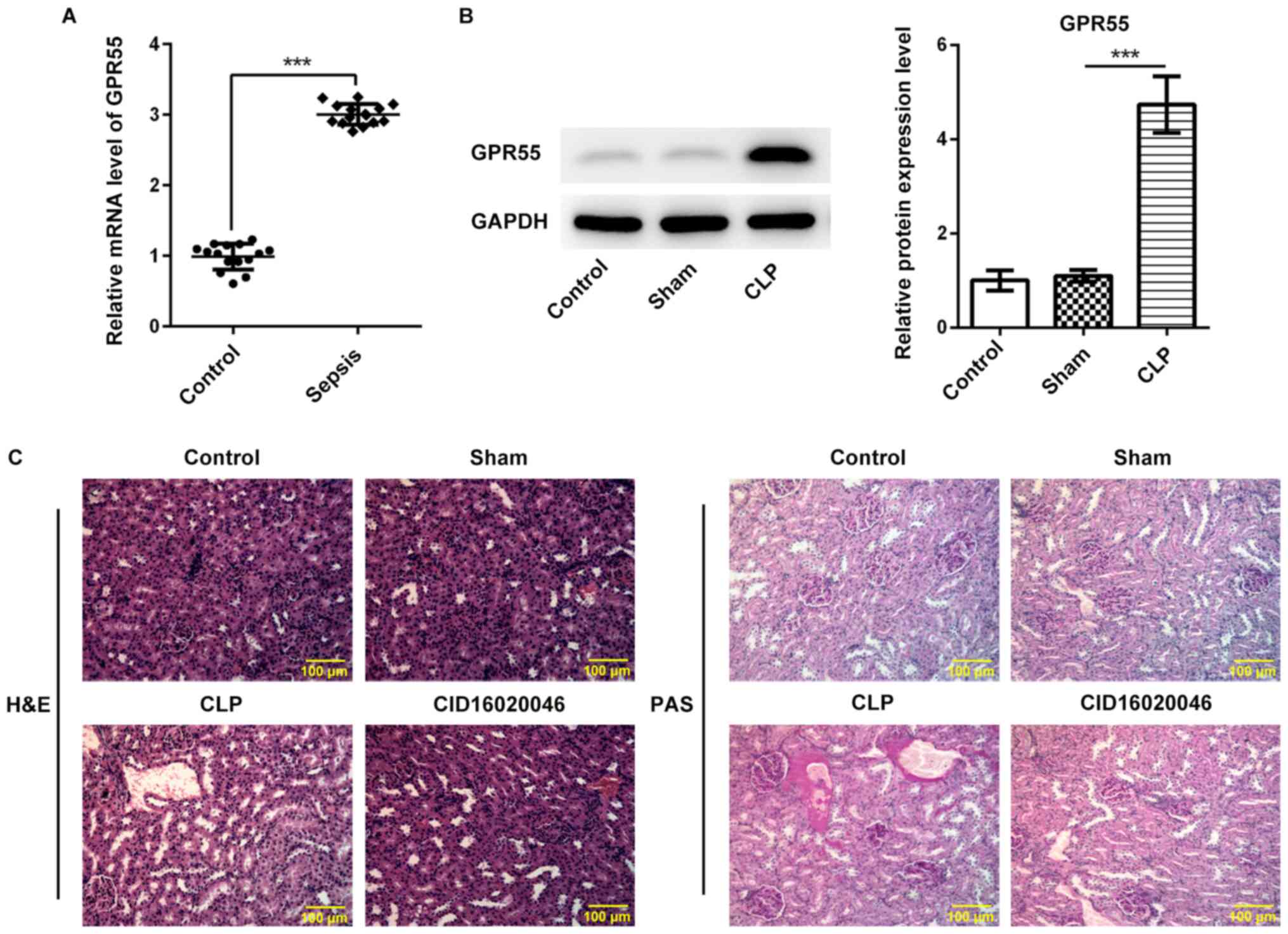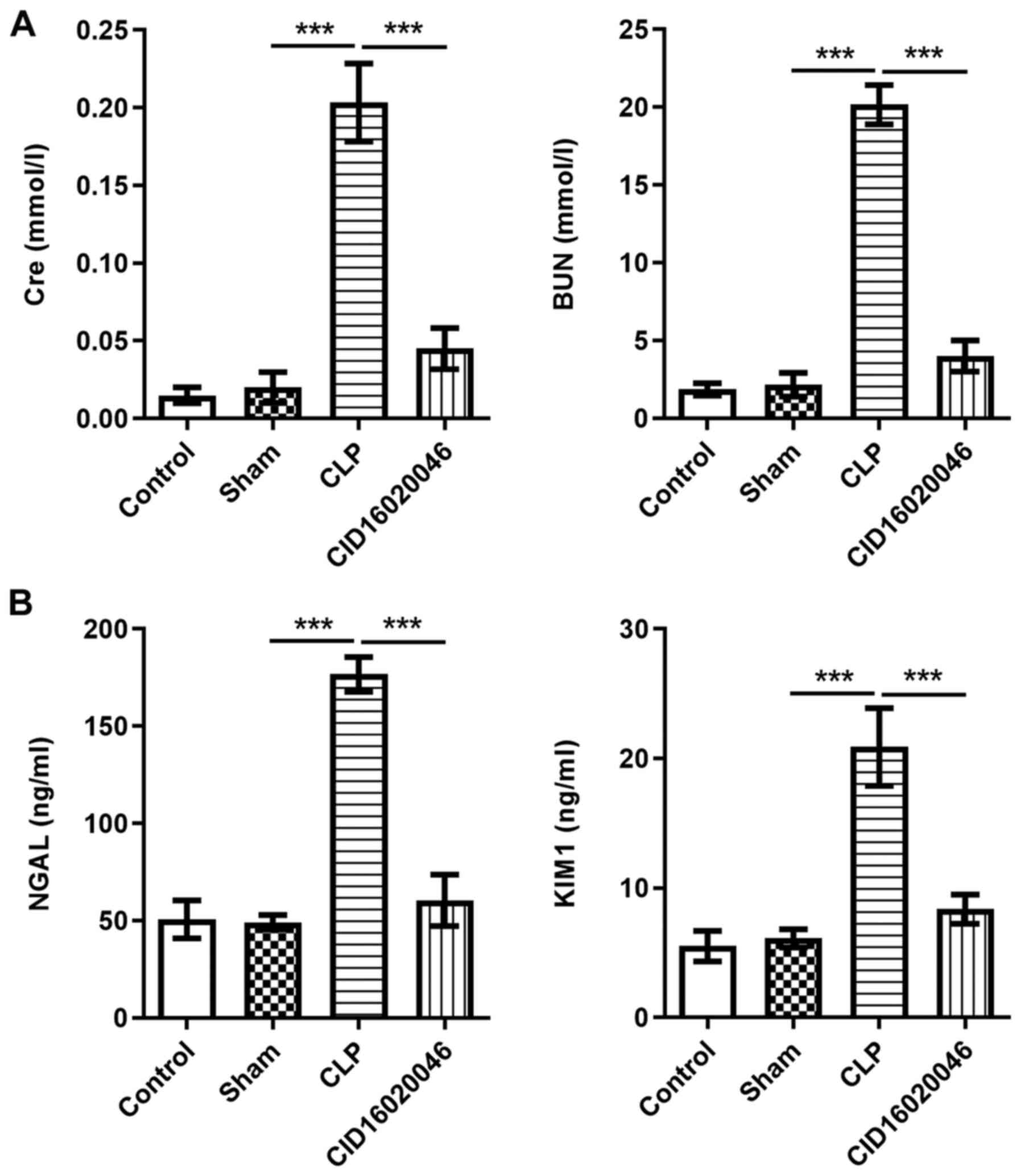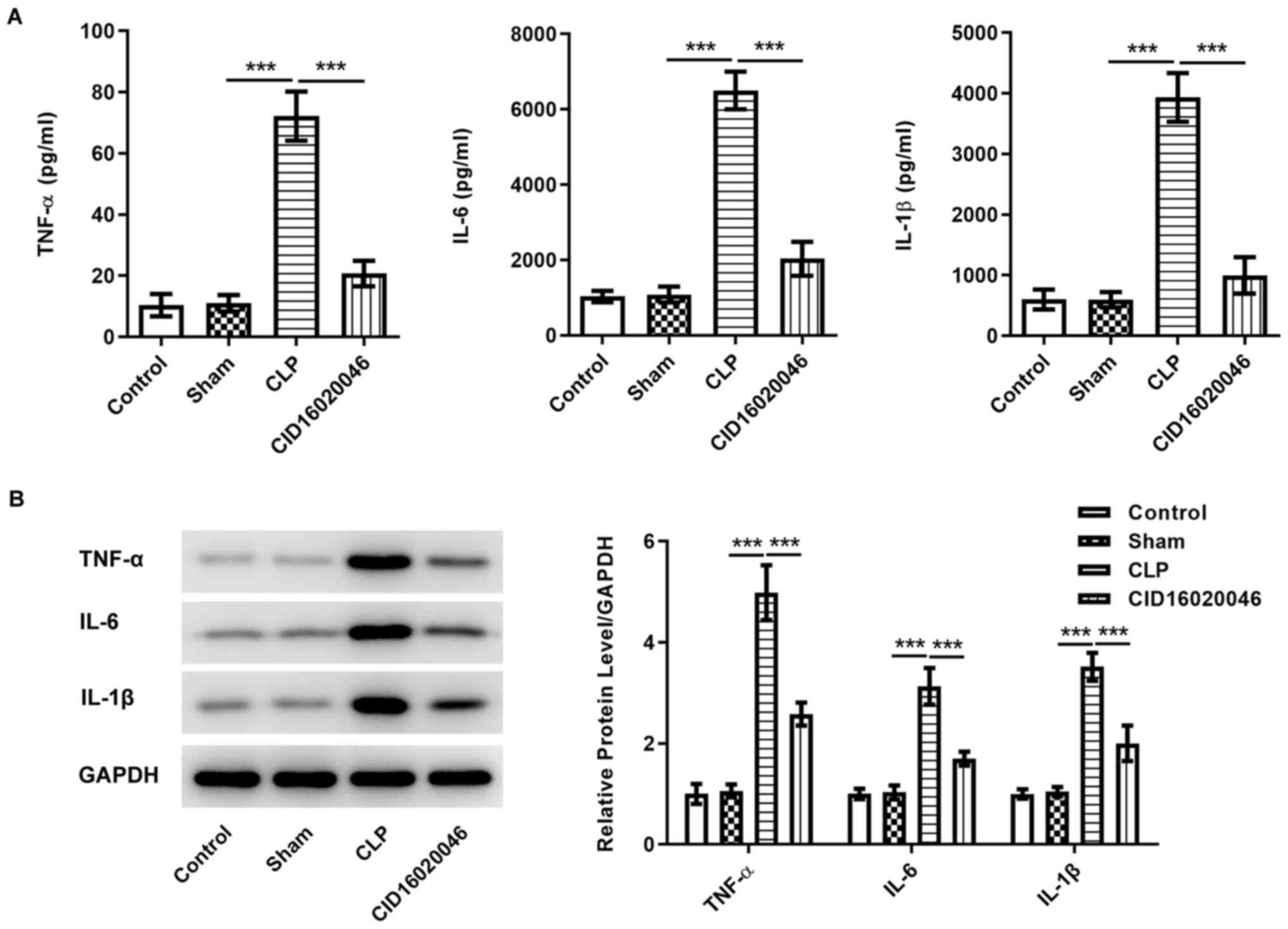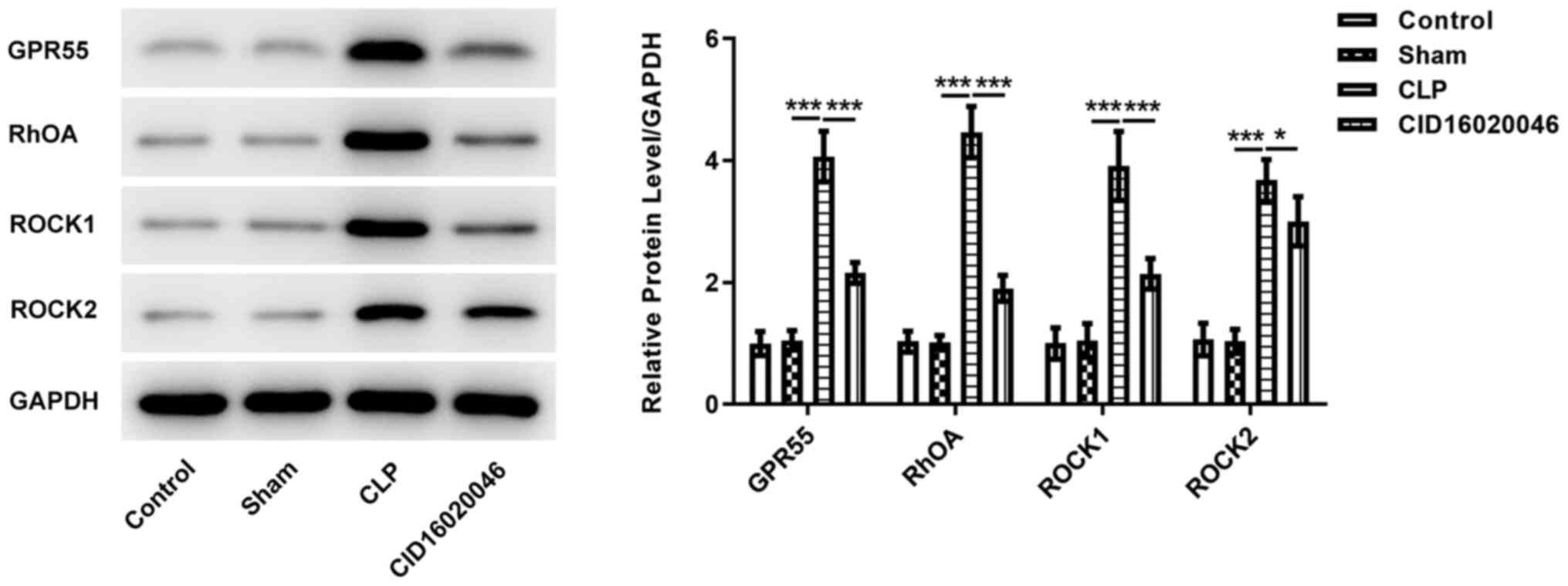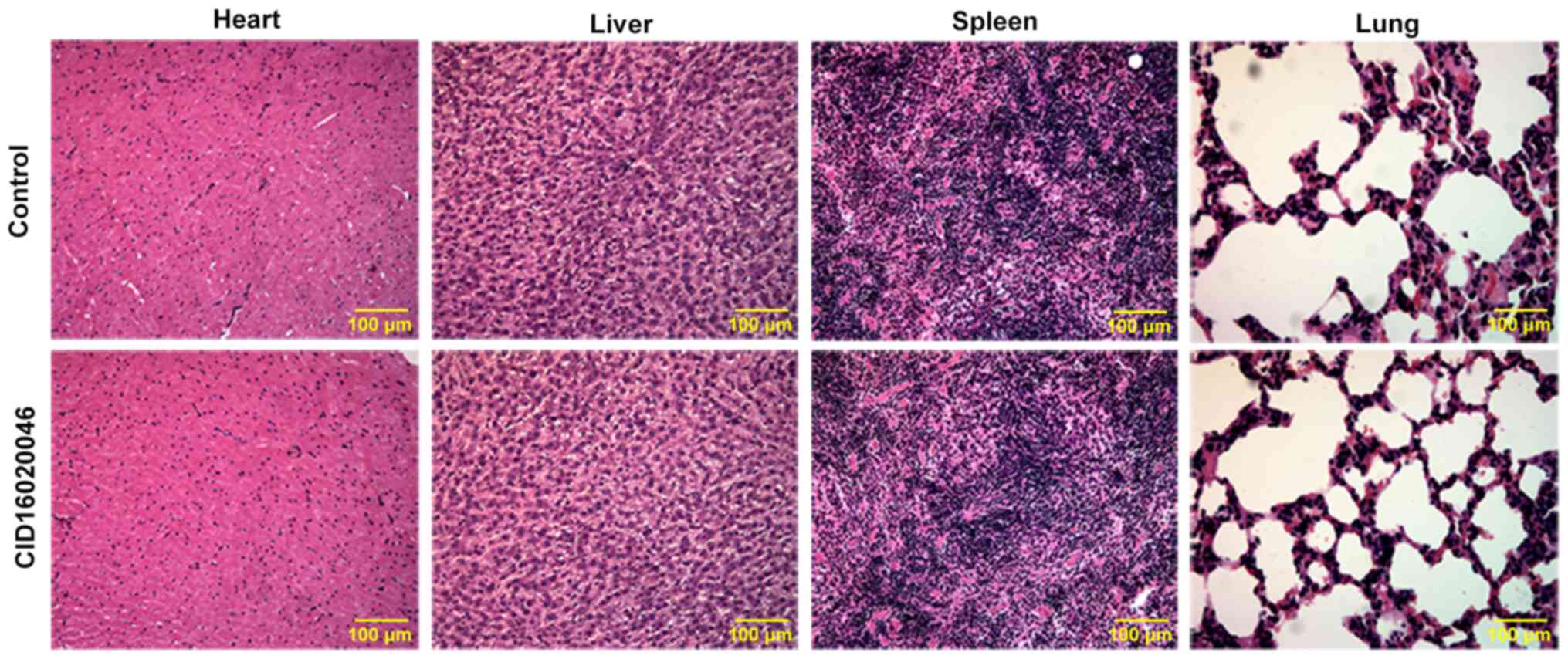|
1
|
Fleischmann C, Scherag A, Adhikari NK,
Hartog CS, Tsaganos T, Schlattmann P, Angus DC and Reinhart K;
International Forum of Acute Care Trialists, : Assessment of global
incidence and mortality of hospital-treated sepsis. Current
estimates and limitations. Am J Respir Crit Care Med. 193:259–272.
2016. View Article : Google Scholar : PubMed/NCBI
|
|
2
|
Shankar-Hari M, Phillips GS, Levy ML,
Seymour CW, Liu VX, Deutschman CS, Angus DC, Rubenfeld GD and
Singer M; Sepsis Definitions Task Force, : Developing a new
definition and assessing new clinical criteria for septic shock:
For the third international consensus definitions for sepsis and
septic shock (sepsis-3). JAMA. 315:775–787. 2016. View Article : Google Scholar : PubMed/NCBI
|
|
3
|
van der Poll T, van de Veerdonk FL,
Scicluna BP and Netea MG: The immunopathology of sepsis and
potential therapeutic targets. Nat Rev Immunol. 17:407–420. 2017.
View Article : Google Scholar : PubMed/NCBI
|
|
4
|
Vincent JL, Jones G, David S, Olariu E and
Cadwell KK: Frequency and mortality of septic shock in Europe and
North America: A systematic review and meta-analysis. Crit Care.
23:1962019. View Article : Google Scholar : PubMed/NCBI
|
|
5
|
Uchino S, Kellum JA, Bellomo R, Doig GS,
Morimatsu H, Morgera S, Schetz M, Tan I, Bouman C, Macedo E, et al:
Acute renal failure in critically ill patients: A multinational,
multicenter study. JAMA. 294:813–818. 2005. View Article : Google Scholar : PubMed/NCBI
|
|
6
|
Ma S, Evans RG, Iguchi N, Tare M,
Parkington HC, Bellomo R, May CN and Lankadeva YR: Sepsis-induced
acute kidney injury: A disease of the microcirculation.
Microcirculation. 26:e124832019. View Article : Google Scholar : PubMed/NCBI
|
|
7
|
Sharir H and Abood ME: Pharmacological
characterization of GPR55, a putative cannabinoid receptor.
Pharmacol Ther. 126:301–313. 2010. View Article : Google Scholar : PubMed/NCBI
|
|
8
|
Schicho R, Bashashati M, Bawa M, McHugh D,
Saur D, Hu HM, Zimmer A, Lutz B, Mackie K, Bradshaw HB, et al: The
atypical cannabinoid O-1602 protects against experimental colitis
and inhibits neutrophil recruitment. Inflamm Bowel Dis.
17:1651–1664. 2011. View Article : Google Scholar : PubMed/NCBI
|
|
9
|
Staton PC, Hatcher JP, Walker DJ, Morrison
AD, Shapland EM, Hughes JP, Chong E, Mander PK, Green PJ, Billinton
A, et al: The putative cannabinoid receptor GPR55 plays a role in
mechanical hyperalgesia associated with inflammatory and
neuropathic pain. Pain. 139:225–236. 2008. View Article : Google Scholar : PubMed/NCBI
|
|
10
|
Stančić A, Jandl K, Hasenöhrl C, Reichmann
F, Marsche G, Schuligoi R, Heinemann A, Storr M and Schicho R: The
GPR55 antagonist CID16020046 protects against intestinal
inflammation. Neurogastroenterol Motil. 27:1432–1445. 2015.
View Article : Google Scholar : PubMed/NCBI
|
|
11
|
Zhou J, Yang H and Lehmann C: Inhibition
of GPR 55 improves dysregulated immune response in experimental
sepsis. Clin Hemorheol Microcirc. 70:553–561. 2018. View Article : Google Scholar : PubMed/NCBI
|
|
12
|
Zeng Q, Wu J and Yang S: Circulating
lncRNA ITSN1-2 is upregulated, and its high expression correlates
with increased disease severity, elevated inflammation, and poor
survival in sepsis patients. J Clin Lab Anal. 33:e228362019.
View Article : Google Scholar : PubMed/NCBI
|
|
13
|
Livak KJ and Schmittgen TD: Analysis of
relative gene expression data using real-time quantitative PCR and
the 2(−Delta Delta C(T)) method. Methods. 25:402–408. 2001.
View Article : Google Scholar : PubMed/NCBI
|
|
14
|
Harjai M, Bogra J, Kohli M and Pant AB: Is
suppression of apoptosis a new therapeutic target in sepsis?
Anaesth Intensive Care. 41:175–183. 2013. View Article : Google Scholar : PubMed/NCBI
|
|
15
|
Song S, Meyer M, Türk TR, Wilde B,
Feldkamp T, Assert R, Wu K, Kribben A and Witzke O: Serum cystatin
C in mouse models: A reliable and precise marker for renal function
and superior to serum creatinine. Nephrol Dial Transplant.
24:1157–1161. 2009. View Article : Google Scholar : PubMed/NCBI
|
|
16
|
Rittirsch D, Huber-Lang MS, Flierl MA and
Ward PA: Immunodesign of experimental sepsis by cecal ligation and
puncture. Nat Protoc. 4:31–36. 2009. View Article : Google Scholar : PubMed/NCBI
|
|
17
|
Han WK, Waikar SS, Johnson A, Betensky RA,
Dent CL, Devarajan P and Bonventre JV: Urinary biomarkers in the
early diagnosis of acute kidney injury. Kidney Int. 73:863–869.
2008. View Article : Google Scholar : PubMed/NCBI
|
|
18
|
Kuchroo VK, Umetsu DT, DeKruyff RH and
Freeman GJ: The TIM gene family: Emerging roles in immunity and
disease. Nat Rev Immunol. 3:454–462. 2003. View Article : Google Scholar : PubMed/NCBI
|
|
19
|
Kuwabara T, Mori K, Mukoyama M, Kasahara
M, Yokoi H, Saito Y, Yoshioka T, Ogawa Y, Imamaki H, Kusakabe T, et
al: Urinary neutrophil gelatinase-associated lipocalin levels
reflect damage to glomeruli, proximal tubules, and distal nephrons.
Kidney Int. 75:285–294. 2009. View Article : Google Scholar : PubMed/NCBI
|
|
20
|
Guo Y, Zhai J, Zhang J and Zhou H: NGAL
protects in nasopharyngeal carcinoma by inducing apoptosis and
blocking epithelial-mesenchymal transition. Oncol Lett.
19:3711–3718. 2020.PubMed/NCBI
|
|
21
|
Han M, Pan Y, Gao M, Zhang J and Wang F:
JNK signaling pathway suppresses LPS-mediated apoptosis of HK-2
cells by upregulating NGAL. Int J Inflam.
2020:39805072020.PubMed/NCBI
|
|
22
|
Wang Y, Pan W, Wang Y and Yin Y: The GPR55
antagonist CID16020046 protects against ox-LDL-induced inflammation
in human aortic endothelial cells (HAECs). Arch Biochem Biophys.
681:1082542020. View Article : Google Scholar : PubMed/NCBI
|
|
23
|
Garofalo AM, Lorente-Ros M, Goncalvez G,
Carriedo D, Ballén-Barragán A, Villar-Fernández A, Peñuelas Ó,
Herrero R, Granados-Carreño R and Lorente JA: Histopathological
changes of organ dysfunction in sepsis. Intensive Care Med Exp. 7
(Suppl 1):S452019. View Article : Google Scholar : PubMed/NCBI
|
|
24
|
Vong CT, Tseng HHL, Kwan YW, Lee SM and
Hoi MPM: Novel protective effect of O-1602 and abnormal
cannabidiol, GPR55 agonists, on ER stress-induced apoptosis in
pancreatic β-cells. Biomed Pharmacother. 111:1176–1186. 2019.
View Article : Google Scholar : PubMed/NCBI
|
|
25
|
Akimov MG, Ashba AM, Gretskaya NM and
Bezuglov VV: N-acyl dopamines induce apoptosis in PC12 cell line
via the GPR55 receptor activation. Dokl Biochem Biophys.
474:155–158. 2017. View Article : Google Scholar : PubMed/NCBI
|
|
26
|
Vong CT, Tseng HHL, Kwan YW, Lee SM and
Hoi MPM: Novel protective effect of O-1602 and abnormal
cannabidiol, GPR55 agonists, on ER stress-induced apoptosis in
pancreatic β-cells. Biomed Pharmacother. 111:1176–1186. 2019.
View Article : Google Scholar : PubMed/NCBI
|
|
27
|
Wan L, Bagshaw SM, Langenberg C, Saotome
T, May C and Bellomo R: Pathophysiology of septic acute kidney
injury: What do we really know? Crit Care Med. 36 (4
Suppl):S198–S203. 2008. View Article : Google Scholar : PubMed/NCBI
|
|
28
|
Lochhead PA, Wickman G, Mezna M and Olson
MF: Activating ROCK1 somatic mutations in human cancer. Oncogene.
29:2591–2598. 2010. View Article : Google Scholar : PubMed/NCBI
|
|
29
|
Shimizu S, Tahara M, Ogata S, Hashimoto K,
Morishige K, Tasaka K and Murata Y: Involvement of nuclear
factor-kB activation through RhoA/Rho-kinase pathway in LPS-induced
IL-8 production in human cervical stromal cells. Mol Hum Reprod.
13:181–187. 2007. View Article : Google Scholar : PubMed/NCBI
|
|
30
|
Park JW, Park CH, Kim IJ, Bae EH, Ma SK,
Lee JU and Kim SW: Rho kinase inhibition by fasudil attenuates
cyclosporine-induced kidney injury. J Pharmacol Exp Ther.
338:271–279. 2011. View Article : Google Scholar : PubMed/NCBI
|
|
31
|
Hu H, Chen W, Ding J, Jia M, Yin J and Guo
Z: Fasudil prevents calcium oxalate crystal deposit and renal
fibrogenesis in glyoxylate-induced nephrolithic mice. Exp Mol
Pathol. 98:277–285. 2015. View Article : Google Scholar : PubMed/NCBI
|
|
32
|
Yan XX, Zheng AD, Zhang ZE, Pan GC and
Zhou W: Protective effect of pantoprazole against sepsis-induced
acute lung and kidney injury in rats. Am J Transl Res.
11:5197–5211. 2019.PubMed/NCBI
|
|
33
|
Vong CT, Tseng HHL, Kwan YW, Lee SM and
Hoi MPM: G-protein coupled receptor 55 agonists increase insulin
secretion through inositol trisphosphate-mediated calcium release
in pancreatic β-cells. Eur J Pharmacol. 854:372–379. 2019.
View Article : Google Scholar : PubMed/NCBI
|
|
34
|
Robertson-Gray OJ, Walsh SK, Ryberg E,
Jönsson-Rylander AC, Lipina C and Wainwright CL:
l-α-Lysophosphatidylinositol (LPI) aggravates myocardial
ischemia/reperfusion injury via a GPR55/ROCK-dependent pathway.
Pharmacol Res Perspect. 7:e004872019. View
Article : Google Scholar : PubMed/NCBI
|















